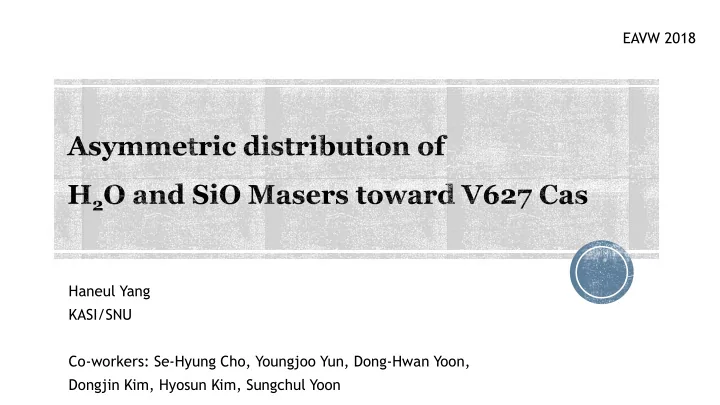

EAVW 2018 Haneul Yang KASI/SNU Co-workers: Se-Hyung Cho, Youngjoo Yun, Dong-Hwan Yoon, Dongjin Kim, Hyosun Kim, Sungchul Yoon
Interacting binary systems (cool giant + hot dwarf) Rich and complex circumstellar envelope (winds, accretion disks, bipolar jets) excellent laboratory for exploring From the various aspects of interactions and animation made by evolution in binary systems. NASA
SiO and H2O maser emission SiO masers: nearby stellar surface H 2 O maser: outside the dust layer Giving the temperature, density, velocity of the maser-emitting regions Useful probe for investigating morphology and dynamics of the dusty circumstellar envelope of the cool star
Suspected, D(Dusty)-type symbiotic star RA: 22 57 40.9676, Dec: +58 49 12.5578 M2-4II giant star + white dwarf (Kolotilov et al. 1991.) Pulsation period: ~ 466 days (Kolotilov et al. 1997.) LSR velocity: -54 km/s (GAIA) A symbiotic star emitting strong SiO and H 2 O masers (Cho et al. 2010)
4 band simultaneous observation with KVN 22 GHz H2O and 43/42/86/129 GHz SiO masers Single-dish observation 2011/10/18~2018/06/15 30 epoch VLBI observation 2015/01/23~2018/06/02 22 epoch First VLBI observation
Red cross position of RG The number of SiO maser spots West: ~75%, East: ~25% The average intensity West: ~2.5 Jy, East: ~1.0 Jy Trace of suspected outflow motion in the SiO 43, 42 GHz maser at NW
H2O maser at only west-side No blueshifted velocity at H2O maser
The reason of asymmetric structure a hot dwarf H 2 O maser: decayed by UV photon SiO masers: disturbed by wind interaction zone
The reason of asymmetric structure a hot dwarf H 2 O maser: decayed by UV photon SiO masers: disturbed by wind interaction zone
Find the exact position of hot dwarf Estimate the unclear parameters Separation Orbital period distance
H2O, SiO masers in V627 Cas: asymmetric distribution The effect of the hot dwarf H2O maser: decayed by UV photon SiO maser: disturbed by wind interaction zone There are challenges to discover the position of WD in V627 Cas
Recommend
More recommend